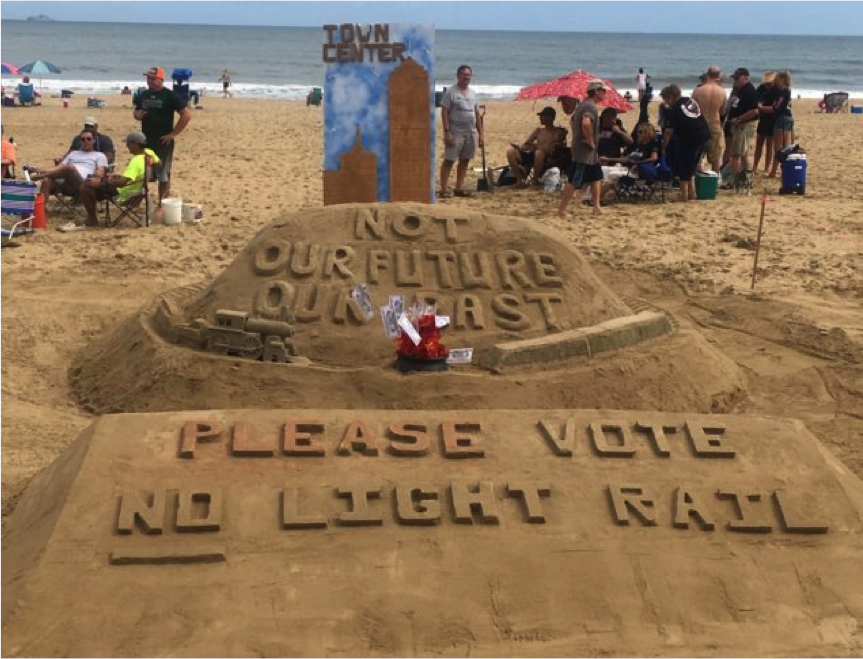November 4, 2016
Next week Virginia Beach will vote on a $243.1 million project to build 3.5 miles of light rail that connects with neighboring Norfolk’s starter line, The Tide.
The story is emblematic of the constant push-pull of politics and policy in shaping local transportation projects. It stretches back across three decades of Virginia’s largest city oscillating between lukewarm enthusiasm and outright rejection of light rail proposals – a long string of advances and setbacks attributed to fluctuating public opinion, divisions among local leaders, and one critical, incremental step that finally led the way forward.
In 1989, the Virginia Beach City Council voted 6-5 against a proposed light rail project. Ten years later, 56% of residents voted against yet another iteration in a 1999 referendum.
Another decade after voters rejected the referendum, the city council took a different tack by purchasing a 10.6-mile rail corridor owned by Norfolk Southern. The purchase was funded by a $20 million state grant, $10 million from the city, $5 million from Hampton Roads Transit Authority, and $5 million through a Dominion Virginia Power Plan easement that will be worth $100,000 annually in rent.
Suddenly, the project became much more tangible.

Source: Hampton Roads Transit
In 2011, shortly after Norfolk opened The Tide, Virginia Beach voted developing the newly acquired land to extend the starter rail line through its city limits. The referendum passed with 63% in favor of the city council using “all reasonable efforts. . . to support [its] financing and development.”
On Tuesday, residents will take the (ostensibly) final step of voting on a referendum asking whether local funds should be used to extend The Tide into Virginia Beach, establishing a 10.9-mile rail network between the two cities.
Financing
The $243.1 million Virginia Beach line would be financed through a combination of local, state, and federal funds. The city is estimated to spend $59.3 million without contingencies or $88.1 million with contingencies.
Project Cost Estimate Based on Preliminary Engineering (2017 Dollars)
| CATEGORY |
ESTIMATED COST (MILLIONS) |
| Design-Builder Light Rail Estimate |
$157.60 |
| Major Utility Relocations |
$12.00 |
| Right of Way |
$24.80 |
| Rail & Support Vehicles |
$21.00 |
| Professional Services |
$27.70 |
| Estimated Total Project Cost |
$243.10 |
The city’s portion is funded in part by a 1.8-cent real estate tax increase passed in May 2015 by its city council. This amounts to a $45 increase for a $250,000 home, covering construction and the cost of operation, which is about two million annually.
The remaining $155 million will be paid by the state, which has set aside $155 million for the project.
Referendum
While the referendum is non-binding, the city council will use it to ensure that public opinion still favors the project. According to the Virginian-Pilot, the local newspaper, a majority of the city council plans to vote in accordance with the outcome.
But The Tide’s performance in Norfolk is casting significant doubt. In 2014, the starter line was the second-most subsidized system per ride in the country according to the FTA National Transit Database. Weekday ridership is slowing. The Wall Street Journal ran an op-ed criticizing the “Tide-tanic” just two weeks before Election Day.
The opposition is led by John Atkinson, the city’s treasurer, who argues that the prior 2011 referendum was not clear enough in its wording. Last year, Atkinson galvanized resistance by taking out a half-page newspaper advertisement that criticized The Tide’s performance in Norfolk and stated:
“. . .the Virginia Beach Extension won’t move many people, won’t eliminate traffic jams, and it won’t create much economic growth. It will move Virginia Beach closer to becoming a core city, and with the problems associated with a core city. I wish I could vote no. How about you?”

Source: No Light Rail in Virginia Beach
Although a referendum was not scheduled prior to Atkinson’s ad, he managed to collect 32,000 signatures from local residents afterwards to place the question on this month’s ballot. The Virginia Beach Tea Party and City Councilman John Moss have joined Atkinson’s opposition, hosting a light rail forum on Wednesday night in conjunction with the Cato Institute, a libertarian think tank.
An early October poll found that residents’ opinion of the project largely correlates with the presidential candidate they support: 63% of Trump voters opposed the line, while 64% of Clinton voters supported it. With a 4.5% margin of error, the result was 49% opposed and 48% in favor (3% were undecided).
If the measure passes and the city council votes in favor, the City of Virginia Beach will proceed with designing and building the light rail line using city funds and financial support from the state. The city will order 3 light rail vehicles to allow the Tide to maintain the same operating schedule on its extended route, and then select contractors and award contracts by April 2017.
If the measure does not pass, the state’s $155 million contribution will be returned to the statewide transportation pot. The city’s $59.3-88.1 million contribution was earmarked for the project, and it is not readily apparent where the funds will be returned.





